Kanban: Definition, 6 Rules, and its Benefits
Kanban is a crucial part of the Just in Time (JIT) system, which we discussed…
Sean Thobias
May 17, 2025Lean manufacturing is a crucial strategy for companies facing fierce manufacturing competition. In this regard, let’s delve into the meaning of lean manufacturing, its benefits, and the different types of waste it eliminates.
Lean manufacturing, also called the Toyota Production System, is a production process that aims to achieve more with less time, space, materials, machines, and human labor. Its objective is to deliver products or services that precisely meet customer needs.
The main goal of lean manufacturing is to eliminate waste and improve profitability. In the modern economy, lean manufacturing is the only effective strategy.
Lean manufacturing activities work together, support each other, and are guided by shared thinking. To help you better understand lean manufacturing, we can use the House of Lean Production, described below.
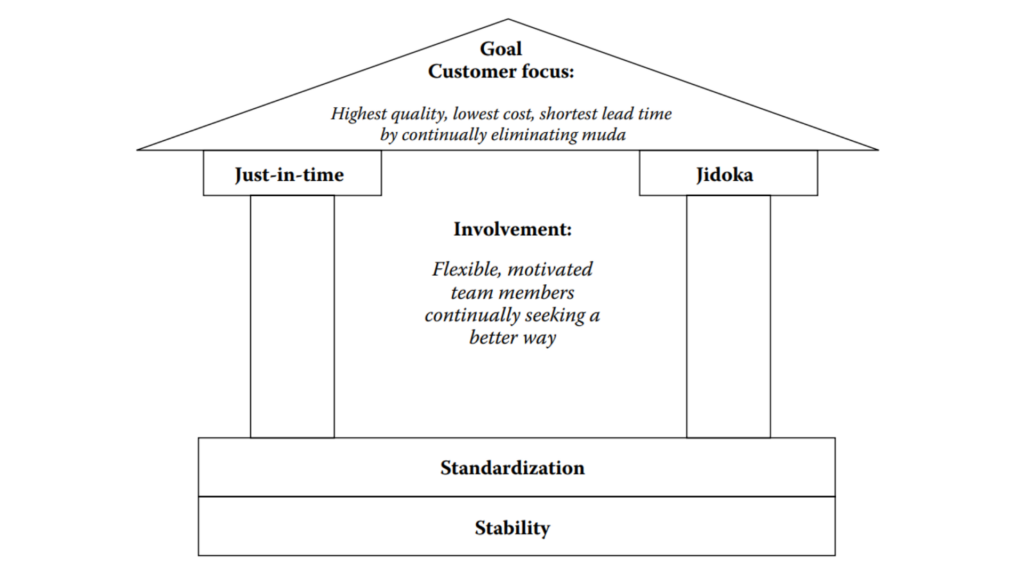
Source: Dennis, P. (2017); Lean production simplified; Basic Image of Lean Production
The foundation of the House of Lean is stability and standardization. Just-in-Time (JIT) delivery for parts and integrating automation with human expertise (Jidoka) represents its walls.
The system’s roof aims to prioritize customer focus by delivering high-quality products at low cost and quickly. This system centers around engagement, creating a flexible and motivating environment where each team member constantly strives to improve production methods.
At Toyota, all activities are interconnected and guided by a shared mindset. The strength of the Toyota system lies in continuously reinforcing the core concept of lean manufacturing through various activities, as shown in the figure below.
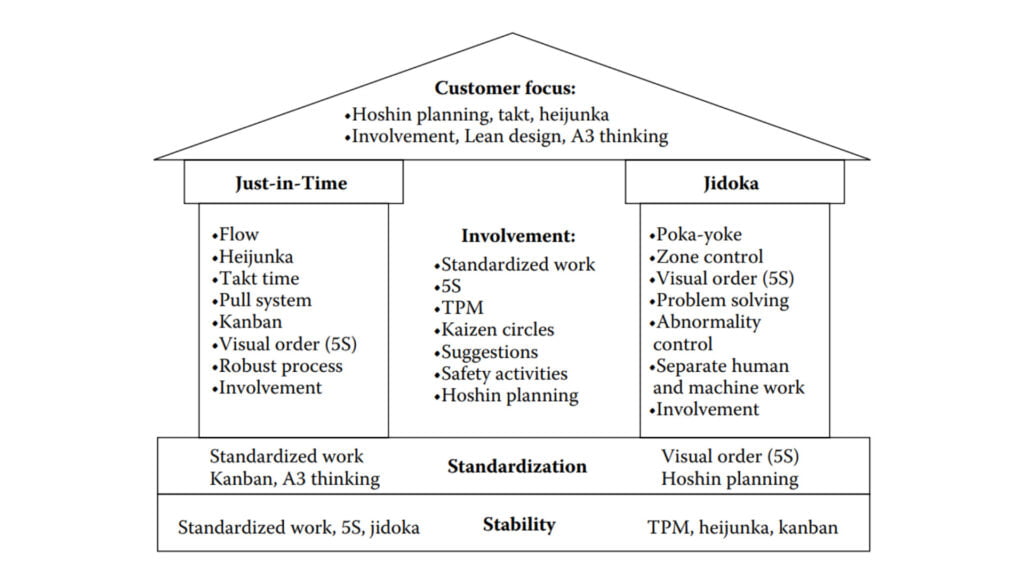
Source: Dennis, P. (2017); Lean production simplified; Basic Image of Lean Production
The Toyota Motor Company, founded in 1937, began lean manufacturing. In its early years, Toyota encountered a crisis that led to the creation of lean manufacturing principles.
In 1950, Eiji Toyoda, who started Toyota Motor Company, went to Ford’s Rouge factory in Detroit. The Rouge factory was the world’s most prominent and influential manufacturing complex.
The visit aims to understand how to enhance productivity at Ford. Upon their return to Japan, Eiji and Taiichi Ohno concluded that mass production would not be effective in Japan. They explored various alternatives to improve the production system.
Toyota faces the challenge of a small local market that needs different types of vehicles. To solve this problem, Taiichi Ohno created a system called lean manufacturing. This system helps companies with limited capital by encouraging using versatile and right-sized machines and efficient ways to switch between different vehicle types.
Furthermore, laws that prevented firing employees during that time also influenced the company’s perception of its community. As a result, this created a solid foundation for encouraging active employee participation and making it easier to solve problems together.
Ohno worked for 30 years to improve and use the lean manufacturing system at Toyota. Ohno made the Operations Management Consulting Division (OMCD) in Toyota factories and suppliers to strengthen this system. Regardless of the circumstances, this system consistently delivers positive results.
There are essentially three primary reasons for utilizing lean manufacturing, which include:
The biggest challenge of the twenty-first century isn’t just about information technology. It’s mainly about reducing costs. Now, let’s compare the old and new ways of calculating profits:
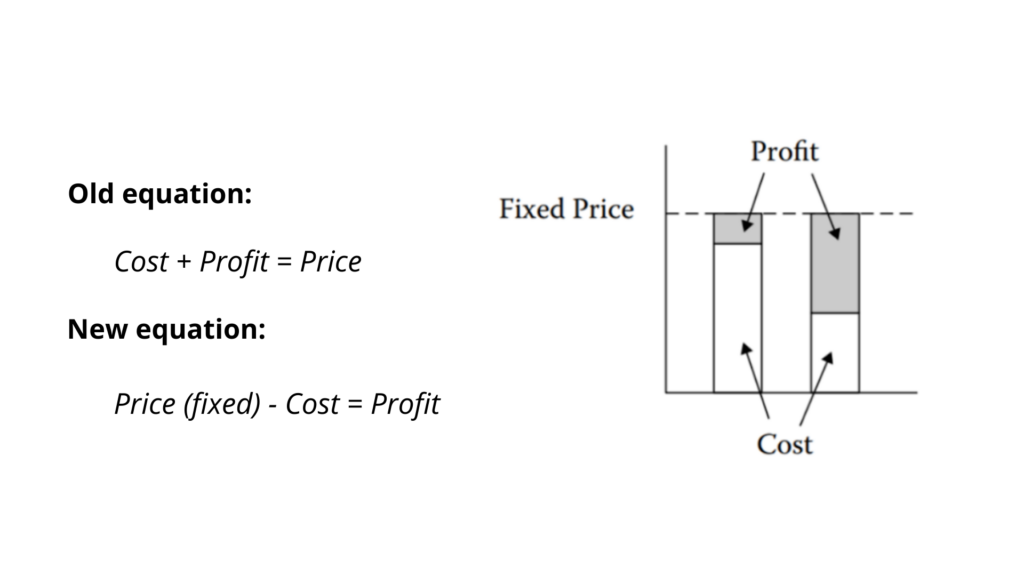
Source: Dennis, P. (2017); Lean production simplified; Basic Image of Lean Production
Can a company enhance product quality and offer customers more without cutting costs? However, cost reduction shouldn’t involve the following:
A practical cost reduction approach is actively engaging team members in improvement efforts. The Toyota system effectively minimizes waste by involving team members in enhancing corporate standards.
A system is a collection of interconnected parts that work together towards a specific goal. There are several critical characteristics of a system, which include:
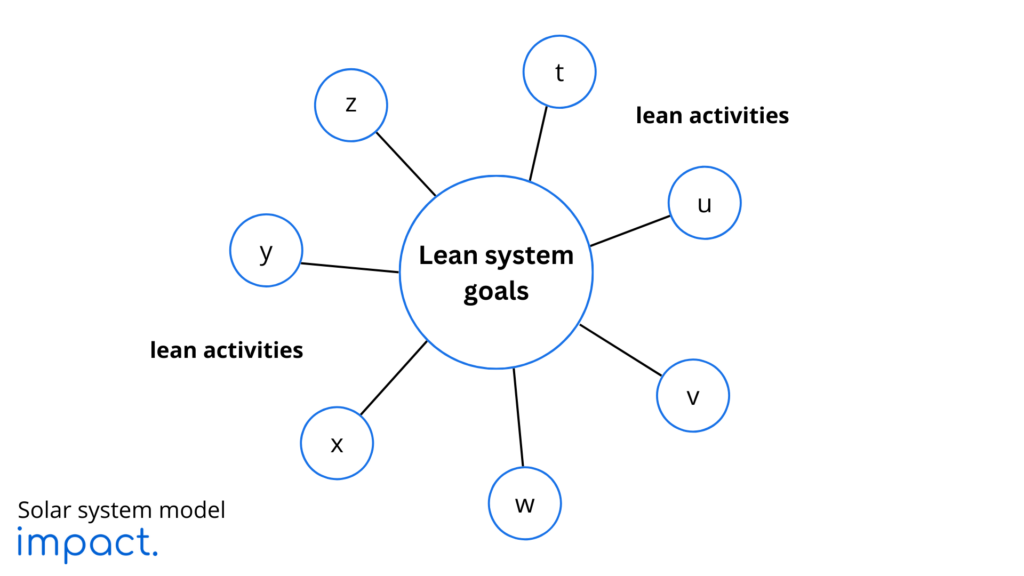
We can understand a system better by using a solar model. In this model, the system’s goal is like the “sun” at the center, and the different activities or components of the system are like the “planets” surrounding it. The closer an action is to the “sun,” the more likely it is to help achieve the goal.
The company should focus on the most critical activities when creating this system and organize them accordingly. Keep in mind that the solar system is just an example. Establishing a practical connection between the system model and its real-life implementation is crucial for ensuring the effectiveness of the lean manufacturing system.
The diagram below depicts how the lean manufacturing system model relates to actual practice. Companies must transform activities labeled as tuvwxyz into actions labeled as TUVWXYZ. However, this can be challenging in a fast-paced manufacturing environment.
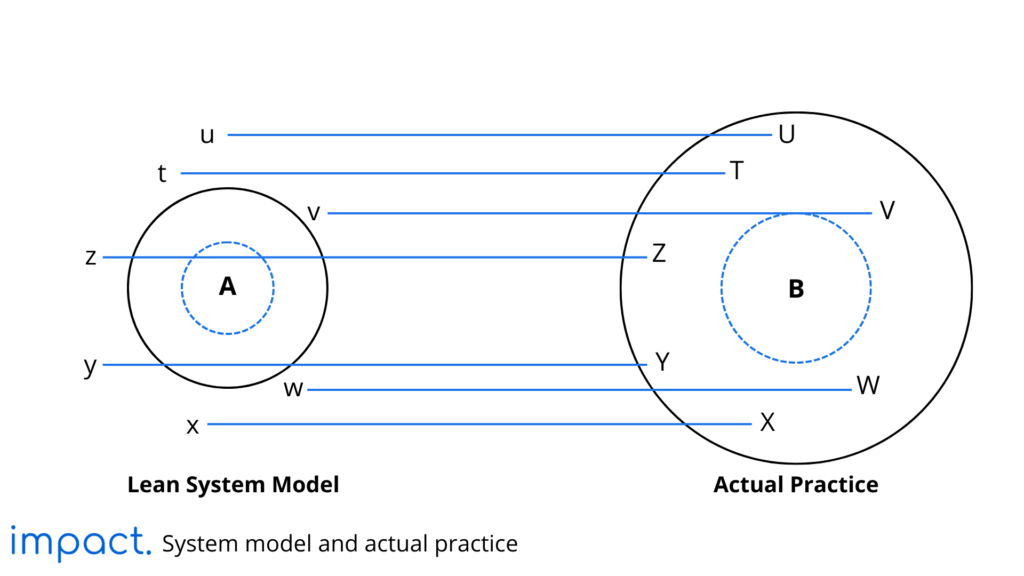
Once you grasp the system, system thinking is the next important idea to understand. System thinking involves thinking within a system framework and understanding how to lead a system effectively.
However, learning system thinking can be complex because people often react quickly to immediate threats. It is crucial to take the time to develop a deeper understanding of system thinking to overcome this tendency.
Lean manufacturing leaders emphasize the principle of the “thinking way.” In the manufacturing industry, implementing this thinking approach is crucial for developing the most efficient production methods.
Through promoting self-awareness and regular practice, this approach strives to enhance our thinking and foster the development of improved mental models. These mental models, shaped by our personality, upbringing, and experiences, encompass our beliefs about how things function.
When it comes to manufacturing, nine fundamental aspects highlight the contrasting mental models between lean manufacturing and conventional methods:
| Conventional | Toyota/Lean manufacturing |
| Constantly producing to meet the quota. | Stopping production to ensure it never has to stop. (Jidoka concept) |
| Producing as much and as fast as possible. (Push system) | Producing goods according to customer orders. (Pull system) |
| Produce many items at once and move them slowly through the system. (Batch and queue) | Create one item at a time and move it quickly through the system. (Flow) |
| You must do it! (Leader = boss) | What do you think? (Leader = teacher) |
| We have several standards in place. (Unclear if they’re being followed or where they’re located) | We have a simple visual for all essential things. |
| Engineers and specialists create standards. We all follow their instructions. | The closest to the job create standards and bring in specialists when necessary. |
| Cover existing problems. | Transparent in showing problems. |
| Only workers go to the shop floor. | Leaders see the shop floor themselves. |
| Do-Do-Do-Do! | Plan-Do-Check-Act (PDCA) |
There are three benefits of implementing lean manufacturing, which include:
Lean manufacturing focuses on reducing waste in materials and worker inefficiencies. There are different types of waste, such as unnecessary movement, excess inventory, waiting time, overproduction, and transportation.
To apply lean manufacturing effectively, the production staff must actively participate. The production staff observes the production process and identifies waste sources in the company. Afterward, the company evaluates these findings. When workers actively contribute to improving processes, their suggestions and ideas can be turned into practical initiatives, increasing job satisfaction.
Lean manufacturing aims to reduce waste by prioritizing loyal customers. Meeting the needs of all customers can lead to inefficiency. Building solid relationships with loyal customers increases interaction and ensures stable income.
Lean manufacturing aims to eliminate waste and unproductive activities in the production process. It identifies three types of production inefficiencies: muda, mura, and muri. Let’s delve into their explanations:
There are three main types of human motion involved in the production process:
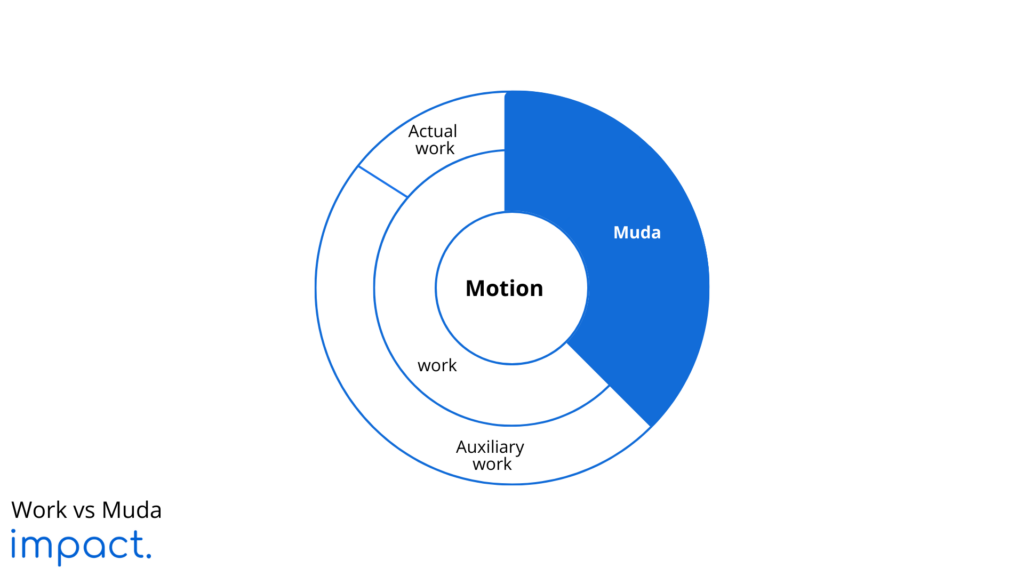
Based on these three types of movement, with muda being the only movement, it tends to be detrimental to the company because it doesn’t generate meaningful contributions.
Muda refers to activities in production that customers aren’t willing to pay for. It is the opposite of what customers perceive as valuable, including everything they want to invest in.
In its application, muda divides into eight different types.
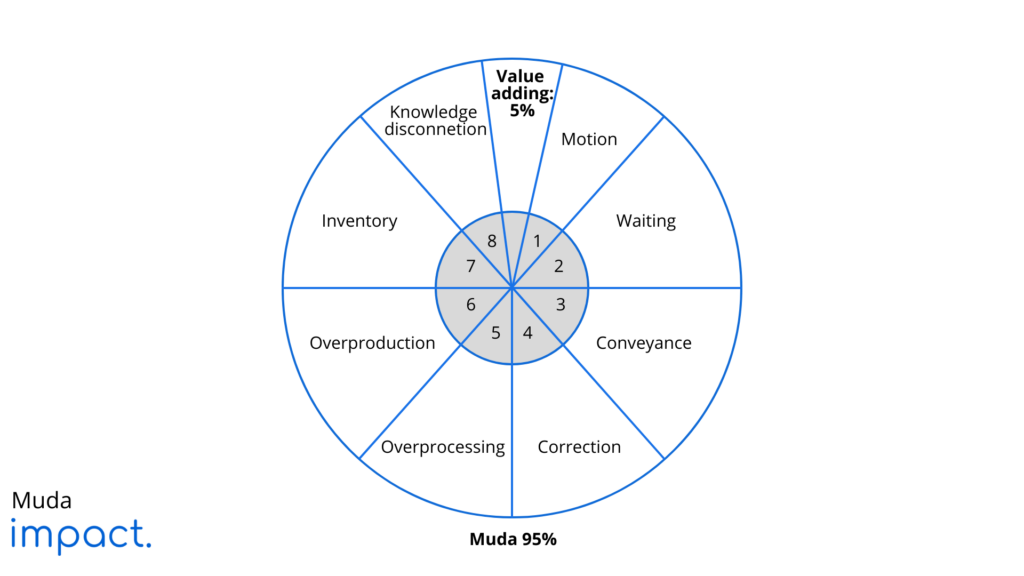
1. Motion/movement waste
In the workplace, motion refers to waste when humans and machines are not working efficiently together. When the ergonomic design is not good, it can cause problems with how much work gets done, the quality of the work, and how safe it is.
It is essential to focus on ergonomics to reduce the strain on people’s movements. Research shows that over half of all workplace injuries in North America happen because of ergonomic problems.
2. Delay/waiting waste
Delays or waiting waste happens when employees have to wait for materials to arrive, when a production line stops for cleaning, or when they have to wait for a machine to finish processing a part. These delays and waiting times can shorten the lead and retention times.
Lead time refers to the time it takes from when an order is received to when the customer receives the completed order. It includes the lag time and waiting time throughout the production process. To calculate the lead time, you can use the following formula:
Lead time = Processing time + Retention time
3. Conveyance/transport waste
Conveyance refers to waste when things are transported or moved around. It’s a prominent type of waste that occurs because of inefficient work setups, too big equipment, or old-fashioned ways of doing things.
Conveyance waste, delay waste, and motion waste are interconnected. This relationship arises because employees must transport raw materials to the factory to facilitate work processes.
4. Correction
Correction or repair involves fixing or repairing products that are flawed or defective. This waste includes all the materials, time, and energy used to produce and improve faulty products.
5. Overprocessing
Overprocessing is a type of waste that often goes unnoticed and occurs when production processes exceed what customers need. This particular form of waste is commonly observed in companies that engineering departments primarily run.
6. Inventory
Inventory waste typically arises from storing raw materials, spare parts, and unnecessary work in progress (WIP). This situation occurs when there are blockages in the factory’s flow and production fails to meet market demands. Companies often maintain significant inventory levels when they rely on Material Requirements Planning (MRP) for production scheduling.
7. Overproduction
This waste happens when too much is produced, leading to suboptimal sales of the final product. It results in unnecessary costs such as construction, maintenance, extra parts, raw materials, labor, and energy. This waste also triggers additional types of refuse like motion, waiting, conveyance, correction, and inventory.
8. Knowledge disconnection/miscommunication
This kind of waste happens when there are misunderstandings or a lack of communication within the company. For instance, it can occur between the company and its customers or suppliers. Such situations can block the smooth exchange of knowledge, ideas, and creativity, leading to frustration and missed opportunities for the company.
Mura refers to unevenness or variations in work, often caused by frequent changes in production plans. The goal of the lean manufacturing system is to minimize mura by using a technique called heijunka or product leveling. This technique involves mixing different models on the production line.
For instance, let’s consider a scenario where a production line manufactures a complex model for half of the shift and a simpler model for the remaining half. In such cases, an employee may work intensively on the complex model for half of the day and then switch to the simpler model for the other half.
Muri is a term used to describe challenging work. Muri may result from inconsistent production, inefficient work procedures, uncomfortable or ill-fitting equipment, inadequate tools, and vague instructions. To address muri, the company must assess and improve equipment or product design plans through evaluation.
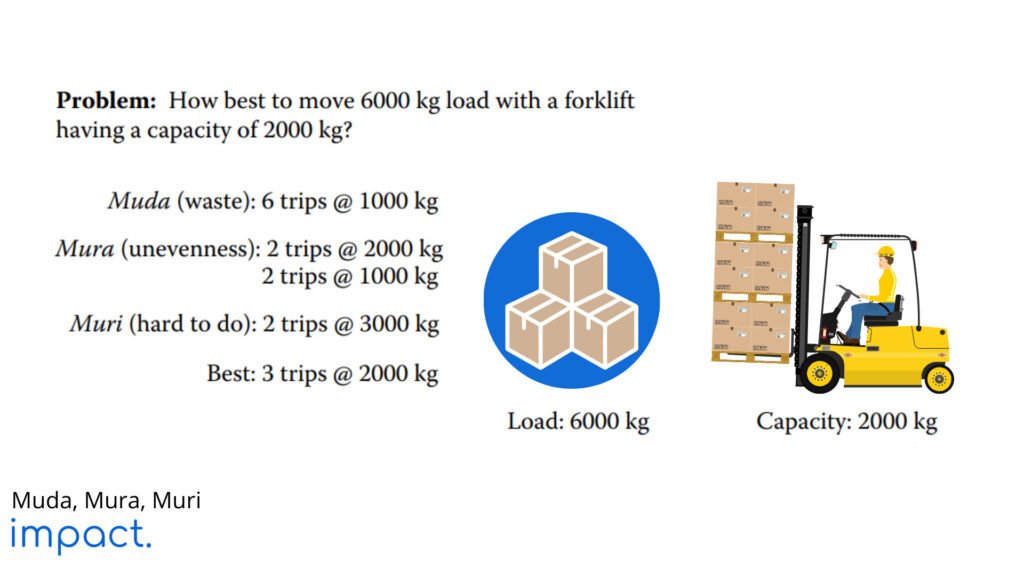
Implementing lean manufacturing is an effective strategy for cutting waste and boosting company profits. The House of Lean Production provides a straightforward approach to comprehending the practical application of lean manufacturing.
This system targets eight types of waste, known as muda, while also addressing related concepts of mura and muri. Additionally, it enhances positive relationships with both employees and customers. The upcoming chapter will delve further into House of Lean Production’s fundamental aspect – stability.
Dennis, P. (2017). Lean production simplified: a plain-language guide to the world’s most powerful production system. Crc press.
Impact Insight Team
Impact Insights Team is a group of professionals comprising individuals with expertise and experience in various aspects of business. Together, we are committed to providing in-depth insights and valuable understanding on a variety of business-related topics & industry trends to help companies achieve their goals.
See how our ERP provides better value.
Speak with our consultant to explore how we can improve your accounting, processes, and people.
